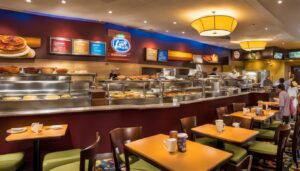Originally posted on December 12, 2023 @ 6:45 pm
Have you ever wondered what termites like to eat for breakfast? These tiny creatures might have surprising dietary preferences. In this article, we will delve into the intriguing world of termite food choices and explore what makes the perfect breakfast for these wood-loving insects.
Contents
- 1 Why are Termites Attracted to Wood?
- 2 How Do Termites React to Treated Wood?
- 3 How Do Termites Interact with Other Building Materials?
- 4 What Other Factors Influence Termite Feeding Habits?
- 5 What Do Termites Eat in the Wild?
- 6 Can Termites Damage Other Materials?
- 7 What Do Pangolins Eat?
- 8 Conclusion
- 9 FAQ
- 9.1 What do termites eat?
- 9.2 Why are termites attracted to wood?
- 9.3 What types of wood are resistant to termites?
- 9.4 How do termites react to treated wood?
- 9.5 How do termites interact with other building materials?
- 9.6 What other factors influence termite feeding habits?
- 9.7 What do termites eat in the wild?
- 9.8 Can termites damage other materials?
- 9.9 What do pangolins eat?
- 9.10 What is the conclusion about termite diet and preferences?
- 10 Source Links
Key Takeaways:
- Termites are attracted to cellulose, a compound found abundantly in wood and tree roots.
- Their digestive system relies on bacterial protozoa living in their stomachs to break down cellulose and convert it into fuel.
- Not all types of wood are equally attractive to termites; some are more enticing than others.
- Cedar and redwood are examples of termite-resistant woods, but even they are not entirely immune to termite damage.
- Treated wood can deter termite infestation, but the effectiveness may vary.
Why are Termites Attracted to Wood?

Termites are fascinating creatures with a particular affinity for wood. This attraction stems from the high cellulose content present in wood, which serves as their primary source of nutrition.
The digestion of cellulose by termites is made possible by the bacterial protozoa that reside in their stomachs. These microscopic organisms form a symbiotic relationship with termites, breaking down the cellulose and converting it into fuel that sustains the insects.
However, not all types of wood are equally appealing to termites. Some woods contain natural compounds or properties that make them less attractive as a food source. Termites have specific preferences when it comes to the characteristics of the wood they consume.
Understanding the factors that influence termites’ wood preferences can help us better protect our homes and structures from termite infestations. By selecting appropriate construction materials and implementing preventive measures, we can minimize the risk of termite damage.
What Types of Wood are Resistant to Termites?

When it comes to protecting your wooden structures from termite infestation, not all types of wood are created equal. Certain varieties have natural properties that make them more resistant to termites. Two examples of termite-resistant wood are cedar and redwood.
Cedar: Cedar wood contains natural oils and resins that act as a deterrent to termites. These oils and resins give cedar its characteristic scent and protect the wood from decay and insect damage. In addition to being termite-resistant, cedar is also known for its durability and beautiful grain. It is commonly used for outdoor structures such as fences, decks, and siding.
Redwood: Redwood is another type of wood that termites tend to avoid initially. It has natural properties that make it resistant to decay and insect infestation. Similar to cedar, redwood contains compounds that act as a deterrent to termites. Redwood is frequently used in outdoor applications like decking, fences, and garden furniture.
While cedar and redwood are considered termite deterrents, it’s important to note that no wood is entirely immune to termite damage. Over time, even these resistant woods can break down or become attractive to termites if they are exposed to decay or excessive moisture. Regular maintenance, such as sealing and treating the wood, is essential to keep termites at bay and ensure the longevity of your wooden structures.
Comparison of Termite-Resistant Woods
| Wood Type | Termite Resistance | Other Benefits |
|---|---|---|
| Cedar | High | Natural oils and resins, durability |
| Redwood | Moderate to high | Natural compounds, resistance to decay |
How Do Termites React to Treated Wood?

When it comes to protecting against termites, pressure-treated lumber is a popular choice. Through a process called pressure treatment, the wood is infused with a preserving agent that not only prevents decay but also creates a chemical barrier against termites. This treatment is especially important for lumber in direct contact with the ground, such as foundation posts, as it helps to prevent termite infestation.
However, it’s essential to note that the effectiveness of treated wood can vary. While pressure-treated lumber is generally resistant to termites, plywood, which contains cellulose, a compound that termites find attractive, may still be susceptible to infestation. Nonetheless, if the plywood is also pressure-treated, the chemical compounds present in the wood make it less appealing to termites.
To better understand the different reactions termites have to various types of wood, let’s take a closer look at the chemical properties of pressure-treated lumber and how it deters termite activity.
“Pressure-treated lumber provides an effective defense against termites by creating a chemical barrier that deters them from infesting the wood.”
How Do Termites Interact with Other Building Materials?
Termites may have a penchant for wood, but how do they interact with other common building materials? Let’s explore how termites navigate through concrete, plastic, sheetrock, and particle board.
Concrete
Termites cannot eat through concrete. However, they can exploit pre-existing cracks in concrete structures to infiltrate buildings. They may also use their jaws to chew through plastic barriers that are in their way. Although termites cannot directly consume concrete, they can use it as a pathway to reach their favorite meal – wood.
Plastic
Similar to concrete, termites cannot eat plastic. However, they can chew through plastic barriers, such as pipes or insulation, to find a path to wood. While termites may not have an appetite for plastic itself, it can serve as an unintentional invitation for them to access and damage wooden structures.
Sheetrock
Sheetrock, also known as drywall, poses a mixed situation for termites. While termites cannot consume the gypsum core of sheetrock, they can partially consume the paper lining, which contains cellulose – their main food source. Termites may eat the outer layer of the sheetrock and search inside for more cellulose-rich materials.
Particle Board
Particle board, made from various wood materials, is highly attractive to termites due to its cellulose content. Termites can easily feast on particle board, especially when it absorbs moisture. Its composition makes it an ideal habitat for termites, providing both a food source and a conducive environment for infestation.
While termites might not voraciously consume concrete or plastic, they can exploit these materials to reach their desired target – wood. Sheetrock contains cellulose, which can be partially consumed by termites, whereas particle board is a true delicacy for these creatures. Understanding how termites interact with different building materials is crucial in implementing effective measures to protect against infestations.
What Other Factors Influence Termite Feeding Habits?

Termites have specific food preferences and are influenced by various factors when it comes to their feeding habits. Understanding these factors can help in preventing termite infestations and protecting wooden structures. Let’s take a closer look at some of these influential factors:
Attraction to Dampened Wood
One factor that influences termite feeding habits is the presence of dampened wood. Some termite species are particularly attracted to moisture in their food source. Dampened wood can provide an ideal environment for termites, making it especially appealing to them. This is why it’s important to address any moisture issues, such as leaks or condensation, as part of termite prevention measures.
Termites and Poplar Wood
Another factor to consider is the relationship between termites and poplar wood. Poplar wood is a type of wood that is a blend of various tree species. As a result, its resistance to termites can vary. While poplar wood may be less attractive to termites compared to other types of wood, it is not completely immune to infestations. Termites may still feed on poplar wood, especially if it is untreated or exposed to moisture.
To further protect against termite infestations, it is recommended to use wood made from naturally resistant trees, such as cypress, redwood, or cedar. These types of wood contain natural properties that can provide better protection against termite damage. However, it’s important to note that no wood is completely immune to termites, and regular preventive measures should still be implemented.
By understanding the food preferences of termites and the factors that attract them, it becomes possible to implement effective strategies for termite prevention. Taking proactive steps to address moisture issues and choosing the right types of wood can significantly reduce the risk of termite infestations and protect your wooden structures in the long run.
What Do Termites Eat in the Wild?

Termites are commonly associated with infesting wooden structures but in their natural habitat, they have a different diet preference. In the wild, termites primarily feed on dead and decaying cellulose. Live trees and bushes are not their preferred food sources as termites prefer cellulose that has already started to break down.
It’s important to note that while healthy, non-decaying trees are generally not a significant food source for termites, there are certain species that can infest and consume live trees. For example, the Formosan Subterranean termite is known to infest live trees under specific conditions.
The presence of decay or moisture within a tree can also attract termites. If a tree has structural damage, rot, or an excessive amount of moisture, it may become susceptible to termite infestation. However, termites primarily thrive and sustain themselves on dead cellulose materials that are in the process of decaying.
As termites play a vital role in the natural ecosystem, breaking down dead plant materials and recycling them into the soil, their diet in the wild is essential for maintaining ecological balance. By consuming dead cellulose, termites contribute to the decomposition process and nutrient cycling in forests and other natural habitats.
Can Termites Damage Other Materials?

Termites are not limited to damaging just wood; depending on the species, they can cause harm to other materials as well. Drywood termites, in particular, have a knack for feeding exclusively on dry, smooth wood. This means that hardwood floors, banisters, and furniture made of dry, smooth wood are prime targets for these pesky insects. With their chewing action, drywood termites create smooth tunnels within the wood, causing damage and weakening the structure.
However, it’s important to note that termites, in general, do not eat through paint. Paint can be effective in protecting against termites, but its effectiveness depends on how well the wood underneath is painted. If the wood is properly painted, with no bare spots or exposed areas, the paint acts as a barrier that can deter termites. On the other hand, if the paint is chipped or cracked, exposing the wood, termites can easily infiltrate and initiate an infestation.
Termites and drywood can be a troublesome combination, as drywood termites have a preference for dry, smooth wood. Their ability to feed exclusively on such wood makes them a significant threat to the integrity of furniture, floors, and other indoor structures. Regular inspections and maintenance are essential in identifying any signs of termite activity early on and taking prompt action to prevent further damage.
Termites and paint: Although termites do not eat through paint, it is crucial to ensure that the wood beneath the paint is adequately protected. Properly painted surfaces create an effective barrier against termites, reducing the risk of infestation. Regular inspection and maintenance of painted surfaces, including touching up any chipped or damaged paint, will help safeguard against termites.
What Do Pangolins Eat?
While not directly related to termites’ favorite breakfast, it’s interesting to note that pangolins, a unique mammal, are also known for their diet consisting of termites and ants. Pangolins are carnivorous creatures and consume a variety of ant and termite species.
Pangolins use their strong sense of smell and hearing to locate their prey, and their long, sticky tongue is key in catching insects from termite or ant mounds. They have a voracious appetite for insects and can consume a significant amount of them in a day.
Pangolins have a unique stomach and digestive system that allows them to process their food efficiently. This enables them to extract maximum nutrition from their diet of termites and ants.
These fascinating creatures play an important role in controlling termite and ant populations in their natural habitats. By feeding on these insects, pangolins help maintain the ecological balance and prevent large-scale infestations.
While our focus in this article is on termites and their favorite breakfast choices, it’s worth appreciating the diverse and interconnected world of nature, where creatures like pangolins and termites coexist.
Conclusion
In conclusion, termites have a specific preference for cellulose-rich materials, making wood their favorite breakfast choice. However, not all types of wood are equally attractive to termites. Some naturally resistant options, such as cedar and redwood, can provide a level of protection against termite infestation. Additionally, treated wood that is infused with a preserving agent can act as a deterrent.
While termites do not consume other building materials like concrete and plastic, they can use these materials as pathways to reach wood. It is important to understand the feeding habits and preferences of termites in order to protect against infestations and ensure the longevity of wooden structures.
To prevent termite infestation, it is recommended to use termite-resistant wood options and regularly maintain and inspect wooden structures. By taking these protective measures, homeowners can safeguard their properties and avoid the costly damage caused by termite activity.
FAQ
What do termites eat?
Termites primarily eat cellulose-rich materials, with wood being their favorite food source.
Why are termites attracted to wood?
Termites are attracted to wood because it contains a high amount of cellulose, which serves as their main nutritional source.
What types of wood are resistant to termites?
Cedar and redwood are naturally resistant to termites, although no wood is completely immune to termite damage.
How do termites react to treated wood?
Treated wood, such as pressure-treated lumber, can be less appealing to termites due to the chemicals infused into the wood.
How do termites interact with other building materials?
Termites cannot eat through concrete or plastic, but they can use them as pathways to reach wood. Sheetrock, which contains cellulose, can be partially consumed by termites. Particle board is highly attractive to termites due to its cellulose content and tendency to absorb moisture.
What other factors influence termite feeding habits?
Termites are attracted to dampened wood and may have preferences for certain types of wood, such as poplar.
What do termites eat in the wild?
In the wild, termites primarily feed on dead and decaying cellulose, rather than live trees and bushes.
Can termites damage other materials?
Drywood termites can feed on dry wood, such as hardwood floors and furniture. Termites, in general, do not eat through paint, although bare wood underneath is more susceptible to infestation.
What do pangolins eat?
Pangolins are unique mammals known for their diet of insects, including termites and ants.
What is the conclusion about termite diet and preferences?
Termites prefer cellulose-rich materials, with wood being their favorite. While some woods are naturally resistant to termites, no wood is entirely immune, and preventive measures should be taken to protect against infestations.








